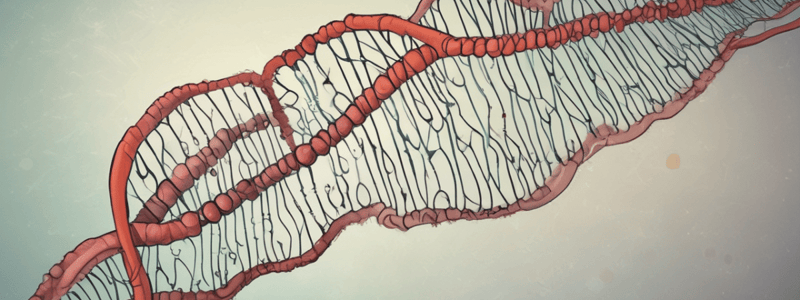Podcast
Questions and Answers
Кои хромозоми осигуряват определянето на пола на човек?
Кои хромозоми осигуряват определянето на пола на човек?
- Аутосомните хромозоми
- X и Y хромозомите (correct)
- 22-те чифтови хромозоми
- Гените близо до центромера
Кое описание е вярно за аутосомните хромозоми?
Кое описание е вярно за аутосомните хромозоми?
- Те контролират пола на индивида
- Те са еднакви по брой и за мъжете, и за жените (correct)
- Се намират в ядрото на клетката
- Има само един вид аутосомни хромозоми
Кое от следното обяснява развитието на мъжките гонади (тестиси)?
Кое от следното обяснява развитието на мъжките гонади (тестиси)?
- Присъствие на допълнителен Y хромозом
- Присъствие на два X хромозоми
- Хормоните, които произвеждат яйчниците
- Действие на гена, кодиращ H-Y антиген (correct)
Каква е ролята на Y хромозомата в процеса на определяне на пола?
Каква е ролята на Y хромозомата в процеса на определяне на пола?
Какво управлява развитието на мъжските гонади след действието на H-Y антигена?
Какво управлява развитието на мъжските гонади след действието на H-Y антигена?
Flashcards are hidden until you start studying
Study Notes
Biology: Genetics
Genetics is a subtopic of biology that explores how traits are passed from parents to their offspring. Genetics is a fundamental aspect of biology, with many branches and subdisciplines, including molecular biology, neurobiology, zoology, and botany. In this article, we will delve into the basics of genetics, including the study of inheritance and chromosomes.
Inheritance Genetics
Inheritance genetics is the study of how traits are passed from one generation to the next. It is based on the principles of dominance and recessiveness. In a dominant allele, the trait is expressed even if the allele is paired with a recessive allele. In contrast, a recessive allele is only expressed when it is paired with another recessive allele.
For example, let's consider a trait for flower color. If one allele (A) determines red flowers and the other allele (B) determines white flowers, a plant with both A and B alleles will have red flowers, as the A allele is dominant. However, if the plant has two B alleles, it will have white flowers, as the B allele is recessive.
Chromosomes
Chromosomes are the thread-like structures that carry genetic information from one generation to the next. They are made up of DNA (deoxyribonucleic acid) and proteins. Humans have 23 pairs of chromosomes, for a total of 46 chromosomes in each cell.
There are two types of chromosomes: autosomes and sex chromosomes. Autosomes are non-sex chromosomes and are numerically equal between males and females (22 pairs each). Sex chromosomes determine the sex of an individual. In humans, females have two X chromosomes (XX), and males have one X chromosome and one Y chromosome (XY).
Sex Determination
Sex determination in humans is a genetic process that occurs during fertilization. The presence of the Y chromosome in the fertilized egg stimulates the development of male gonads (testicles) through the action of a gene located near the centromere, which codes for the production of a cell surface molecule called the H-Y antigen. The male gonadal development is further controlled by hormones produced by the testicles.
In summary, genetics is a crucial subtopic of biology that explains how traits are passed from parents to their offspring. It involves the study of inheritance patterns and chromosomes, with the understanding of dominance and recessiveness playing a significant role in understanding the expression of traits. Additionally, sex determination in humans is a genetic process that is influenced by the presence of the Y chromosome.
Studying That Suits You
Use AI to generate personalized quizzes and flashcards to suit your learning preferences.




